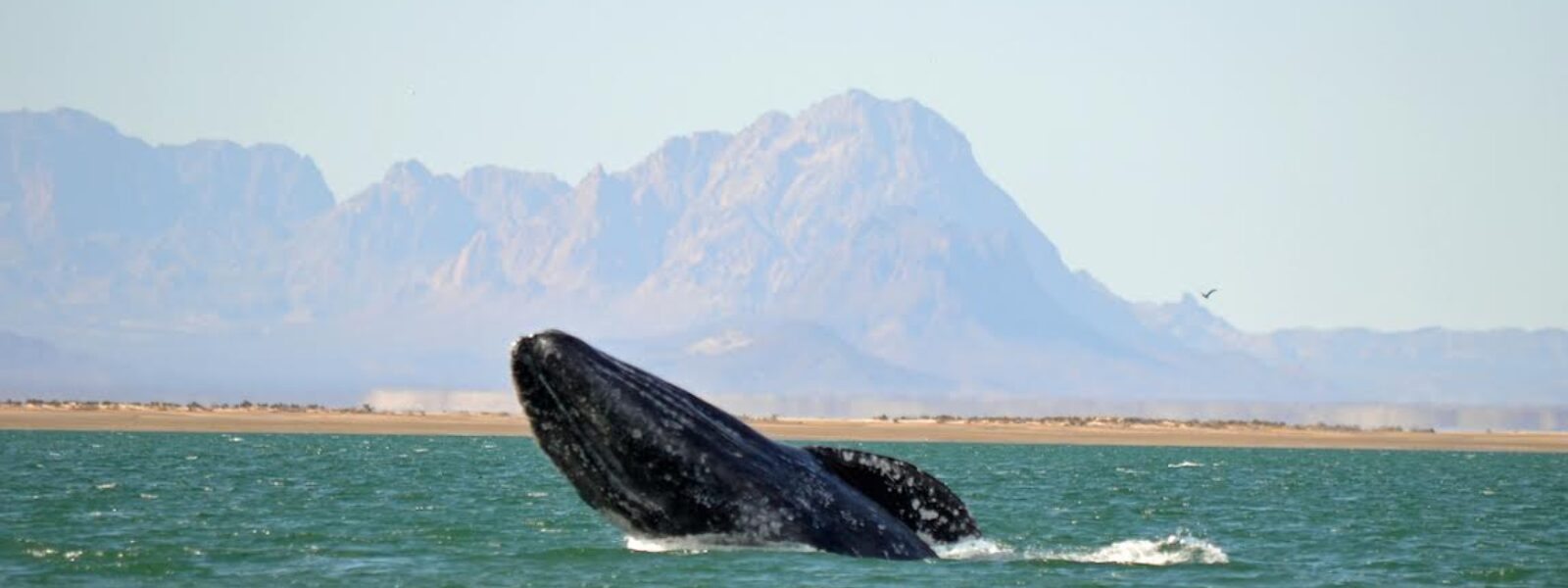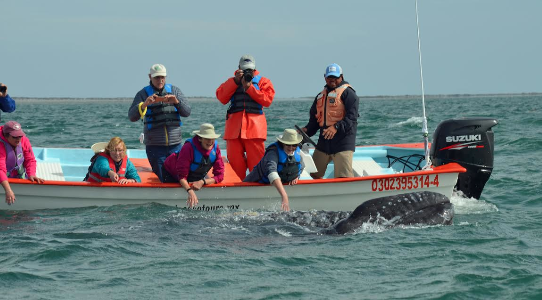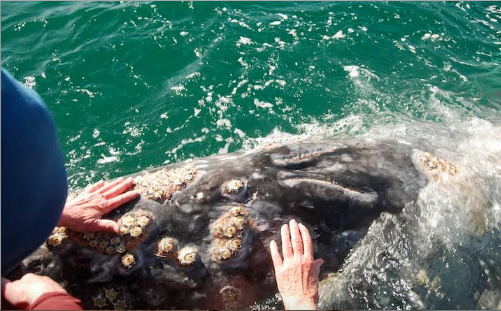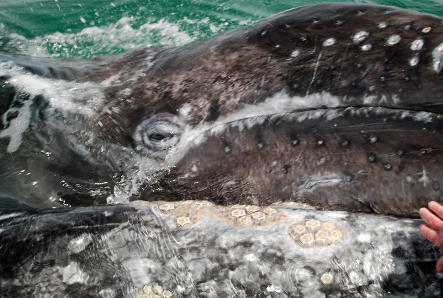

I recently spent three days whale watching (and being watched by whales) in Baja’s San Ignacio Lagoon, one of the three major bays in Mexico where gray whale mothers give birth to their young.
It was a spectacular trip, and I encourage people to go there to experience the wild Baja Peninsula, the desert and the wildlife, and the phenomena of the “friendly” whales.
Gray whales were hunted ruthlessly and experienced two periods of serious decline from human greed. First, they were hunted to near extinction during the late period of Yankee whaling of the 1700s and 1800s. The whalemen called the gray whale the Devil Fish, because of the ferocity with which the female gray whales protected their young. Captain Charles Scammon, who wrote a book about the marine mammals of the California coast and the gray whale fishery, considered the gray whales more dangerous than sperm whales.

With the near extinction of the gray whale and other species, and the collapse of the oil industry in the face of the development of petroleum as a substitute, the hunts ceased for a time around the 1890s. But they were revived in the early 20th Century after World War 1, as whaling fleets from Norway, Japan, United Kingdom and Russia scoured the seas for any whales they could catch. A series of shore stations were set up along the California coast to catch the few gray whales that had returned following the collapse of the Yankee whaling industry. In fact, the last gray whales along the California coast were being killed under scientific permit out of shore stations in San Francisco Bay until 1968, when my mentor Jim Schroeder got wind of the killing and complained to the office of Senator Alan Cranston. Cranston stopped the permits.
Yet gray whales are still hunted extensively in their feeding grounds in the Arctic Ocean. Russians from Siberia obtain a quota of 120 gray whales annually, ostensibly to feed local indigenous people (although a Greenpeace campaign showed that, during the Soviet era, most of the gray whale meat went to feed domestic foxes kept caged for their fur). Alaskan Inuits also get a quota of ten gray whales annually, although reportedly they prefer to eat bowhead whales, for which they also get a quota through the International Whaling Commission.
It is thus remarkable that local Mexican fishermen, who during the gray whale birthing season guide whale-watching trips in the San Ignacio Lagoon, have been able to induce gray whale mothers and their babies to come right up to the small panga boats and be touched by the whale watchers. Hard to say what induces this “friendly” behavior.
In most whale watching around the world, your guide has to watch the horizon for spouts, and then directs the vessel to the location of the whales. Sometimes the whales are skittish and best left alone. At most other times, the whales simply ignore the vessels and go on about their business. Occasionally, an individual whale might approach a boat out of curiosity, but it is a rare occurrence.
In San Ignacio Lagoon, by contrast, the boat putters about slowly, and the whales decide whether or not to make contact. Often, a friendly whale, usually a female with a calf, will approach a boat and surface right next the craft or turn over slowly as the excited whale watchers reach out to pet, rub the gums and baleen, feel the barnacles, and kiss the huge animals. A female gray whale can get 40-50 feet long and weigh in at 30-40 tons. Even the baby gray whales are huge – 18 feet at birth, and they rapidly put on weight nursing on their mother’s rich milk.
 It is hard to know what to make of this behavior. Why are these whales so friendly? They do seem to like to be touched and rubbed by humans (several whales during my trip came up below our boat and gently rubbed their backs along our vessel, a very strange feeling as the boat rises abruptly and the scraping of the barnacles can be felt through the hull). Whales and dolphins, we know, are very tactile and rub and gently bump each other while swimming.
It is hard to know what to make of this behavior. Why are these whales so friendly? They do seem to like to be touched and rubbed by humans (several whales during my trip came up below our boat and gently rubbed their backs along our vessel, a very strange feeling as the boat rises abruptly and the scraping of the barnacles can be felt through the hull). Whales and dolphins, we know, are very tactile and rub and gently bump each other while swimming.
But where does the trust come from? I don’t know. And I don’t know that we humans deserve it, really.
The Mexican government, to its credit, and the local fishermen have done an extremely careful and effective job of protecting these whales. Mexico has often been approached by the government of Japan requesting permission to enter Mexican waters and the lagoons for whaling purposes, and Mexico has repeatedly said no. The San Ignacio Lagoon even has a lookout tower where a government representative enforces whale-watching rules. A small part of the lagoon is open to whale watching, with a strict limit on the number of pangas allowed at any one time. The inner bay is kept clear of whale-watching boats so the whales have a large area to retreat from contact. The fishermen/guides are very careful around the whales, going very slowly in their pangas and avoiding abrupt changes in speed.
All of the fishermen/guides now have four-stroke outboard motors. A few years ago, during a major conservation fight over a proposed industrial salt plant to be located on the San Ignacio Lagoon shores (the government eventually dropped the plan), I proposed a program to replace the local existing two-stroke outboard motors that propel the pangas, which are loud and dump about one third of their fuel and oil into the lagoon during operation. The 4-stroke motors are much much cleaner, although expensive to buy. My colleague Serge Dedina, President of Wildcoast, a Baja-oriented NGO based in southern California, liked my idea and obtained a series of low-interest loans to fishermen so they could buy the outboards.
I called it “Four-strokes for Whale Folks”, and it was very satisfying to return to the lagoon to see the 4-strokes in operation. Thanks to the dedication of the local guides and their allies and the Mexican government, the future of the gray whales in the lagoons of Baja is in very good hands.
I visited the lagoon with Michael Stocker of Ocean Conservation Research , who organizes trips to San Ignacio Lagoon every year. Michael is an acoustician who through OCR has conducted research and advocacy to encourage quieter oceans to protect whales and other marine life from human-induced ocean noise.
We stayed at the beautiful and well-run Antonio’s Eco-camp on the shore of the lagoon. The eco-camp runs entirely on solar and wind electricity and features very nice cabins with beds and outdoor composting toilets. The food is great! I highly recommend the OCR trip and Antonio’s Eco-camp, for a never-to-be-forgotten visit to the friendly whales of Baja.
